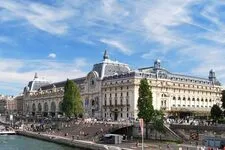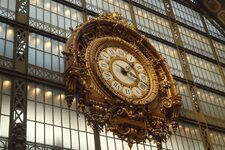Orsay Museum in Paris

Located in the 7th arrondissement of Paris, the Orsay Museum has a very particular history. Once a train station, then a warehouse, and finally a museum, Orsay is today one of the most visited places in the capital.
History of the Museum
Built on the ashes of the Orsay Palace (erected in 1810, it was burned down in 1871 during the Paris Commune), the Orsay Museum was first a train station before becoming the museum we can explore today. It was entrusted to the great French architect of the time, Victor Laloux, and two other architects to create the plans for the terminus of the Orleans Railway Company. The station was intended to welcome visitors and foreign representatives during the 1900 World Exposition. The challenge of establishing such a structure lay in completely harmonizing it with the site on which it was to be built. The neighborhood is indeed very elegant, and the station faced the Louvre and the Tuileries Garden. Thus, it was a matter of integrating this imposing station as well as possible into this rich neighborhood. To do this, Victor Laloux decided to mask the metal structures that faced the outside with an elegant stone facade. Inside the station, the architects opted for modernism. There were thus freight elevators for heavy luggage, elevators for travelers, underground tracks, and a beautiful reception service on the ground floor. Until 1939, the station was a transit point for travelers but also a gathering place for certain associations and political parties that liked to take possession of the place for meetings and banquets.
During World War II, the Orsay station became a center for shipping parcels to prisoners, then a reception center for prisoners during the Liberation. It was only in 1977 that President Valéry Giscard d'Estaing made the decision to build a museum that would use the shell of the station as its decor. Although the official decision to construct the Orsay Museum was made in 1977, it was not until nine years later that the succeeding President François Mitterrand inaugurated the brand new museum.
The Orsay Collections
A major place for collecting Western art objects, the museum has an impressive compilation of paintings, sculptures, photographs, and decorative arts dating from the mid-19th century to the early 20th century. The museum holds a large part of the most beautiful Impressionist paintings, such as the famous Luncheon on the Grass by Edouard Manet, The Origin of the World by Gustave Courbet, Self-Portrait by Vincent Van Gogh, and Bal du Moulin de la Galette by Renoir. The sculptures are not to be missed, as visitors can admire The Little Fourteen-Year-Old Dancer by Degas or the greatest works of Auguste Rodin, the father of modern sculpture.
To periodically enrich its collections, the Orsay Museum also hosts numerous temporary exhibitions that take place in the former station throughout the year. During these exhibitions, visitors are invited to immerse themselves in the artistic world of a painter, sculptor, photographer, or graphic artist. They also highlight an artistic movement or a period, a question in the history of art.
Very ambivalent, the museum also houses an auditorium where various artistic events take place, as well as round tables, concerts, performances dedicated to young people, and film screenings of all kinds.
For your visit, save time and book your tickets online for the Orsay Museum.



